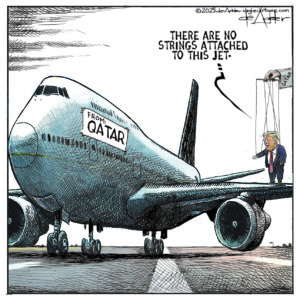What Happens When All We Have Left Is the Pentagon?
If your military is the only well-funded, well-stocked arm of the government, it’s obvious whom you’re going to turn to in any crisis. Sebastian Dooris / Public Domain
1
2
3
Sebastian Dooris / Public Domain
1
2
3
At over $600 billion a year and counting, the Pentagon already receives significantly more than its fair share of federal funds. If President Donald Trump has his way, though, that will prove a sum for pikers and misers. He and his team are now promising that spending on defense and homeland security will increase dramatically in the years to come, even as domestic programs are slashed and entire civilian agencies shuttered.
The new administration is reportedly considering a plan — modeled on proposals from the military-industrial-complex-backed Heritage Foundation — that would cut a staggering $10.5 trillion in federal spending over the next decade. The Departments of Energy, Commerce, Transportation, and State might see their budgets slashed to the bone; the Corporation for Public Broadcasting would be privatized; and (though the money involved would amount to chicken feed) the National Endowments for the Arts and for the Humanities would be eliminated altogether. In the meantime, the ranks of the Army and Marines would be expanded, a huge naval buildup would be launched, and a new Star Wars-style missile defense system would be developed — all at a combined cost of up to $1 trillion beyond the already munificent current Pentagon plans for that same decade.
The specifics won’t be known until Trump’s first budget becomes public in perhaps April or May, but as we wait for it, Republican Senate Armed Services Committee Chairman John McCain has just taken the unusual step of releasing his own spending blueprint for the military. It suggests that a key senator and the president and his team are on the same page when it comes to military funding. At an extra $430 billion over the next five years, the numbers in McCain’s plan are similar to the potential Trump buildup.
One thing is already clear: this drastic tilt toward yet more Pentagon spending and away from investment in diplomacy abroad and civilian needs at home will only further militarize American society, accelerate inequality, and distort the country’s already highly questionable foreign policy. After all, if your military is the only well-funded, well-stocked arm of the government, it’s obvious whom you’re going to turn to in any crisis.
This process was already visibly underway even before Donald Trump took the oath of office. His gut decision to entrust national security policymaking only to military figures was particularly troubling. From National Security Adviser Michael Flynn to Secretary of Defense James Mattis to head of the Department of Homeland Security John Kelly, retired generals and other ex-military types now abound in his administration. Defense analyst and former White House budget official Gordon Adams summed up the risks of this approach recently in this way:
“Putting military officers in charge of the entire architecture of national security reinforces the trend toward militarizing policy and risks cementing in place ‘the military-industrial complex’ that President Dwight D. Eisenhower warned of. To borrow the psychologist Abraham H. Maslow’s words, if all the men around President Trump are hammers, the temptation will be ‘to treat everything as if it were a nail.’”
How the Military Came to Dominate Foreign Policy
President Trump won’t, of course, be starting from scratch in his urge to further elevate the military in foreign and domestic affairs. He’s building on a process that’s already well under way. In the Obama years, for instance, there were a record number of drone strikes, especially outside official U.S. war zones — 10 times the number launched by the Bush administration. Similarly, the Obama administration paved the way for various Trumpian urges by waging wars on multiple fronts and instituting a historic crackdown on whistleblowers in the military and the intelligence communities. It also approved record levels of U.S. arms sales abroad, $278 billion worth of them, or more than double those of the Bush years. (In Trumpian terms: jobs!)
In addition, as part of his pledge to avoid large, “boots-on-the-ground” conflicts like the Bush administration’s 2003 invasion of Iraq, President Obama oversaw a sharp increase in the size of the U.S. Special Operations forces, sending them abroad to arm, train, and fight alongside militaries in 138 countries in 2016. Think of this approach — having a “lighter footprint” while expanding the number of conflicts the United States is involved in — as a case of what I’ve called “politically sustainable warfare.” It seems cheaper, is far less visible, and involves fewer U.S. casualties than full-scale invasions and occupations.
In these years, the Pentagon has also continued to encroach on turf previously occupied by the State Department and the Agency for International Development, including funding its own arms and training programs and engaging in economic development projects. Under the euphemistic term “building partner capacity,” the Pentagon now has the authority to arm and train foreign military forces through no less than 70 separate programs.
Dig, Root, GrowThis year, we’re all on shaky ground, and the need for independent journalism has never been greater. A new administration is openly attacking free press — and the stakes couldn’t be higher.
Your support is more than a donation. It helps us dig deeper into hidden truths, root out corruption and misinformation, and grow an informed, resilient community.
Independent journalism like Truthdig doesn't just report the news — it helps cultivate a better future.
Your tax-deductible gift powers fearless reporting and uncompromising analysis. Together, we can protect democracy and expose the stories that must be told.
This spring, stand with our journalists.
Dig. Root. Grow. Cultivate a better future.
Donate today.









You need to be a supporter to comment.
There are currently no responses to this article.
Be the first to respond.